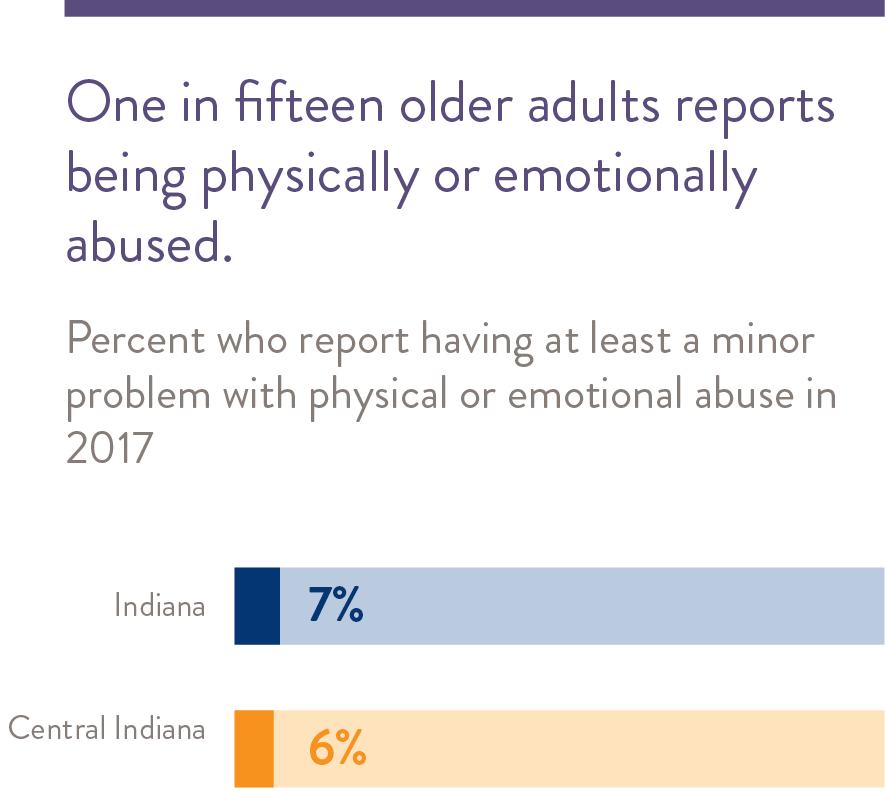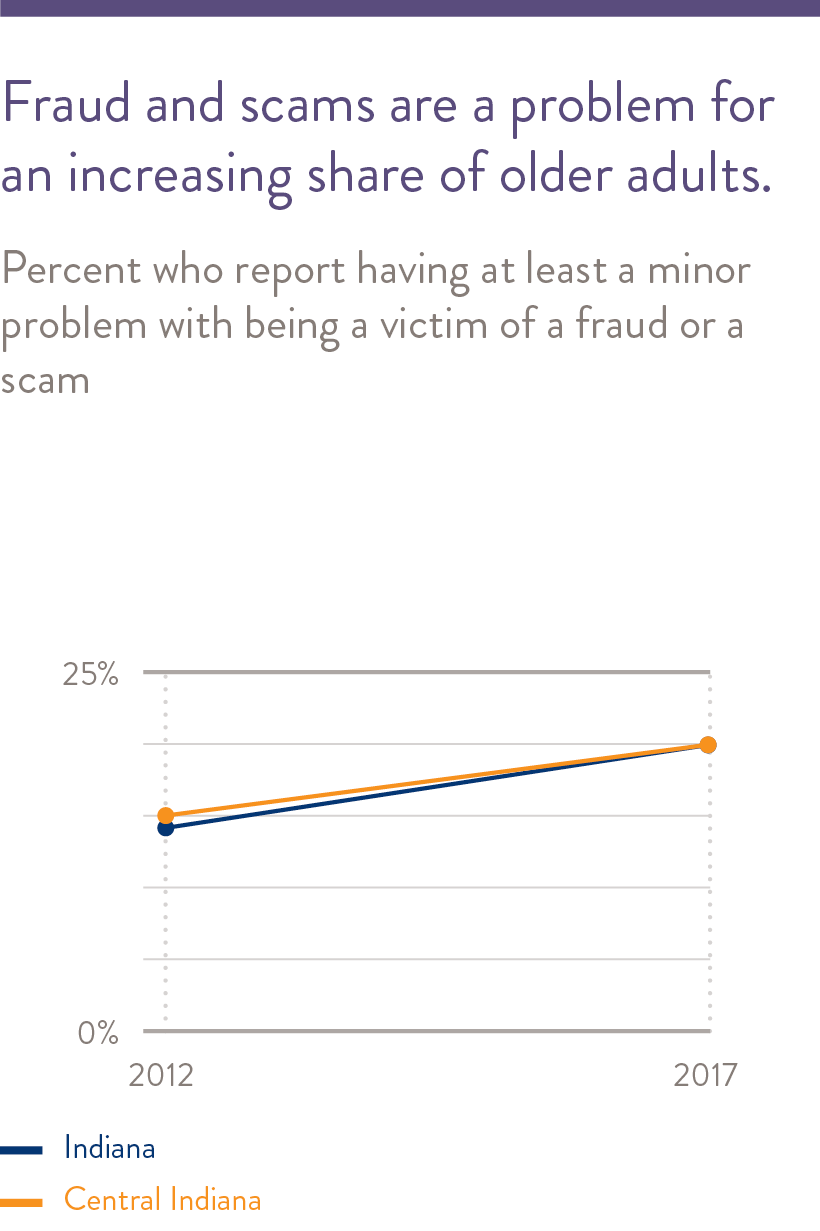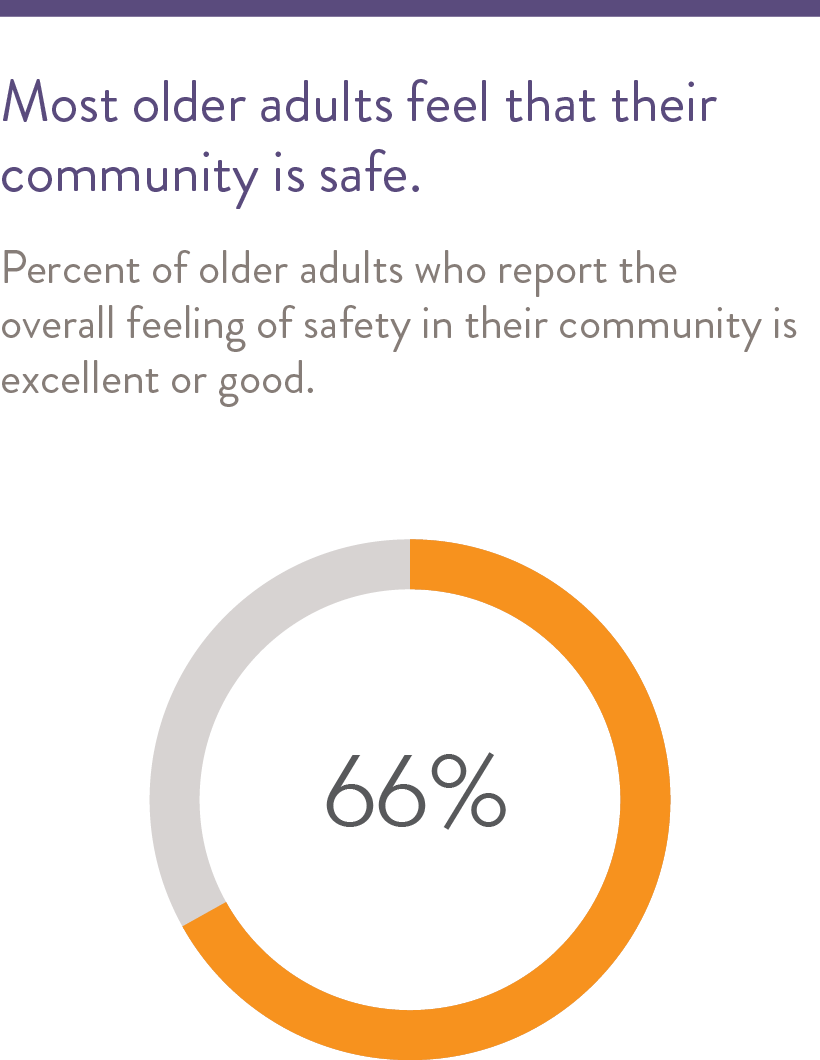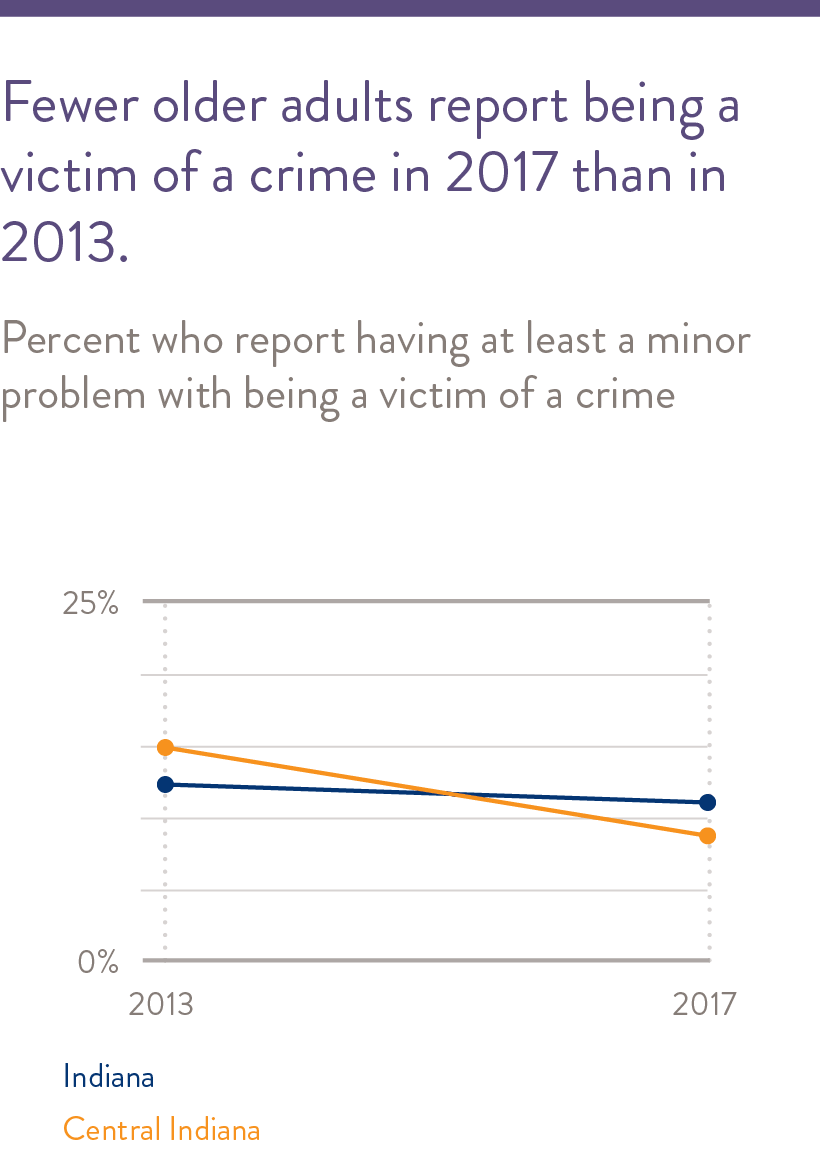Safety and Abuse
Perceived personal safety may be crucial for older adults to age in place with a positive outlook; however, safety varies based on where one lives and the resources one has to maintain social supports and effective caregiving.Perceived personal safety may be crucial for older adults to age in place with a positive outlook; however, safety varies based on where one lives and the resources one has for maintaining social supports and effective caregiving. This section of the report describes elder abuse and crime, including perceptions and experiences affecting the physical safety of older adults. Key findings include:
- Nationally and in Indiana, one in ten adults age 65 and older experiences abuse each year, and this is likely underreported.
- Indiana’s Adult Protective Services has historically lacked sufficient resources and structure to provide social service-related support for endangered older adults in the state.
- Older adults report increases in fraud and scams, which make them feel less safe.
- Perceptions of community safety among older adults in Central Indiana have improved but vary among older adults living in high-crime neighborhoods.
Elder Abuse
According to the National Center on Elder Abuse, elder abuse includes “any knowing, intentional or negligent act by a caregiver or any other person that causes harm or a serious risk of harm to an older adult.”1 Most definitions of elder abuse include physical, sexual, emotional and financial abuse, as well as neglect and self-neglect.
According to the U.S. Department of Justice, nationally at least 10% of adults age 65 and older will experience some form of elder abuse each year.2 However, elder abuse is often unreported, suggesting these rates could be higher.3 Family members are the most common perpetrators of abuse.4 5
A study of a national sample of adults age 60 and older found that over the course of a year, 4.6% experienced emotional mistreatment, 1.6% experienced physical mistreatment and 0.6% experienced sexual mistreatment. The majority of these experiences were not reported to the authorities.6 The 2017 Community Assessment Survey for Older Adults (CASOA™) age 60 and older found that 6% of respondents in Central Indiana reported being physically or emotionally abused during the past year.7 This is similar to the state, across which 7% of respondents reported experiencing these types of abuse.8
Older adults who experience social isolation, cognitive disabilities (including dementia and Alzheimer’s),
or physical disabilities are at an increased risk for abuse.9 10 According to key informants, older adults in Central Indiana may experience multiple forms of elder abuse concurrently, such as neglect and other forms of abuse from a perpetrator.11
Provider concerns include lack of support to prevent abuse
According to an interview with Indiana’s Adult Protective Services (APS), Indiana is unique in its lack of a public guardianship program and lack of regulation around who is eligible to become a guardian. The interviewee also noted underfunding of APS as a challenge—in 2019, a total of 42 investigators served the entire state of Indiana. Even though this number is an increase from the 30 full-time investigators in 2016, this understaffing makes it difficult to effectively address the needs of a large population of older adults. Indiana’s APS is also the only such service nationally that does not operate as a social service agency, instead serving as a justice system to resolve disputes between abusers and partnering with county prosecutors.12 This means that APS investigators do not have direct access to social services such as emergency placement for adults in life-threatening situations. Instead, they must refer to outside agencies, which often have waiting lists for permanent placement options.13

Source: CASOA 2017 14
The present-day social service system is limited in its ability to assist the growing older adult population amid increasing financial abuse.15 While there are some volunteer-based guardianship services available for older adults in the state, only half of the counties in Central Indiana are served by one of these entities.16 In Marion County, the Center for At-Risk Elders (CARE), provides emergency guardianship services to those who need a guardian and lack alternatives. However, according to interviews with service providers, the demand for services is rising at an almost unmanageable rate. In addition to service gaps for guardianship, national research also notes a lack of multicultural frameworks to prevent elder abuse in communities of color, as much research has focused on older adults who are White and middle class.17
Increases in fraud and scams make older adults feel less safe
Between 2013 and 2020, the Office of the Indiana Attorney General received 40,839 consumer calls that included complaints of fraud or scams from adults age 60 and older. Roughly one third of these originated from Central Indiana counties.18 This is likely a gross underestimation, as a large proportion of complainants did not report age data.19 According to 2017 CASOA data, across both the state and Central Indiana, one fifth (20%) of older adults reported that being a victim of a fraud or a scam was a least a minor problem during the past year. This represents a statewide increase of six percentage points between 2013 and 2017.20 21 To learn more about factors that can put older adults at a higher risk of being victims of fraud or scams, please read ’Highlighting Equity’ on page 5.9.
22
Older adults participating in focus groups reported feeling targeted and preyed upon through mailings, robo-calls, telephone scams, identity theft and fraud.23 Some experienced a large volume of mailings and phone calls designed to defraud them of their resources. Specifically, they discussed concerns about being targeted for financial scams in which they are asked to provide personal information and cash.
Focus group participants, especially those with lower incomes, were concerned about who would continue to help them manage their finances, as some trusted their children, while others either lacked supportive family members or did not have anyone they could trust.

Source: CASOA 2017 24
Crime
In 2016, there were 32 property crimes per 1,000 residents in Central Indiana, although crime rates vary from county to county across the region. Marion County had the greatest number of property crimes, at 48 per 1,000 residents, a rate to which no other area county comes close. Boone County had the fewest property crimes, with 4.3 crimes per 1,000 residents.25
County-level violent crime rates are much lower than the property crime rates. In 2016, there were 7.8 violent crimes per 1,000 residents in the region. Once again, Marion County had the greatest number of violent crimes per 1,000 residents, at 13 crimes. Hamilton County had the fewest, at 0.3 per 1,000 residents.26
In a 2017 survey, two-thirds (66%) of older adults in Central Indiana reported that the overall feeling of safety in their communities was excellent or good.27 Similarly, across the state, 64% felt safe in their communities, a two percentage point increase since 2013.28 29 However, some survey respondents reported that being a victim of a crime, regardless of the location where the crime took place, was at least a minor problem for them in the previous year. While 9% of older adults in Central Indiana reported this as a problem in 2017, this represents a six percentage point decrease since 2013.30 31 Similarly, 11% of older adults statewide reported that being a victim of a crime was at least a minor problem, a two percentage point decrease since 2013.32 33
Data from Marion County also suggests that crime impacts older adults, although these rates may diminish by age. Between 2015 and 2019, the Indianapolis Metropolitan Police Department’s (IMPD) Victim Assistance Unit served 48,882 victims of crime. Of these victims, 6,521 (13%) were between 41 and 60 years of age, while 1,313 (3%) were over the age of 60.34
Property Crime Rate
Property crimes per 1,000 residents (2016)
Violent Crime Rate
Violent crimes per 1,000 residents (2016)
Even when older adults are not direct victims of crime, neighborhood crime around them can have a negative effect on older adults, who may not feel safe or may be fearful of leaving their homes. One key informant shared that older adults in her community have a fear of telling others that they are home alone, out of fear of their homes being robbed. Additionally, fear of crime is associated with lower social participation among older adults.37
Neighborhoods with greater socioeconomic inequities have greater levels of violent crime. The socioeconomic characteristics of a neighborhood can lead to crime; however, this relationship is reciprocal, as crime can negatively impact the socioeconomic characteristics of a neighborhood.38 In areas with violent crime, experiences of violence are a cause of psychological distress among residents.39
During several focus groups conducted to inform this report, older adults living in Marion County noted that crime in their neighborhoods and around their homes prevents them from conducting regular business or enjoying where they live. Specific crimes mentioned include robberies, drugs and gun violence. One individual who lived near a running path opted to run laps around her block instead, out of fear of being robbed or attacked. Another person who relied on walking and the bus for transportation mentioned carrying mace and a knife for protection. Another participant reported her grandson was murdered in September 2019 during a robbery. Addressing crime is important to the sense of security and quality of life of older adults living in an area, and it disproportionately affects different Indianapolis neighborhoods.



What factors put older adults at a higher risk for fraud victimization?
Conflicting data exists about whether certain older adult populations are at a higher risk for fraud victimization. However, research has shown that older adults in general are more vulnerable to fraud and scams.
Individual factors:
Declines in cognitive functioning
Older adults with mild cognitive impairment or dementia are more likely to make impaired financial decisions and are less able to discern when fraudulent activities are occurring.40
Low income and low financial literacy
Older adults with lower income and low financial literacy have a higher susceptibility to fraudulent schemes.41
This is of particular concern for older adults, who have been found to have high levels of financial illiteracy. This can impact their ability to recognize scams. In one study, over two-thirds of older telemarketing fraud victims said it was difficult to identify fraud when they encountered it.42

Interpersonal factors: Social isolation
Older adults who are socially isolated are at higher risk for being victims of fraud. These individuals often have strong urges to connect with others, which can make them easy targets for financial abusers. Fraudsters may build “friendships” with these older adults in a ploy to win their trust and exploit them financially. Additionally, older adults who live alone are often easy targets due to less contact with family members.43

Policy factors: Unclear avenues for fraud reporting
Many older adults who are fraud victims do not report it, due in part to a lack of knowledge on where or how to report.44 Even when there is information available on reporting, there may be a lack of clarity or ease in the process. For example, the Indiana Attorney General’s website lists four different organizations and contact numbers for reporting financial exploitation, depending on the type of scam and individuals involved.45 Similarly, even when elder fraud is reported, there are not always adequate resources to investigate or solve these cases. A 2016 IndyStar investigation found that elder financial abuse cases reported to APS were often the lowest priority to investigate due to the organization’s limited resources. One APS official shared that as a result, they did not open some financial exploitation cases until up to seven years after the exploitation had occurred.46 Low levels of reporting and prosecution can further embolden scammers to continue targeting older adults, as there are often few consequences.
- National Center on Elder Abuse, “NCEA – FAQ,” accessed February 4, 2021, https://ncea.acl.gov/FAQ.aspx.
- U.S. Department of Justice, “Elder Abuse Statistics,” n.d., https://www.justice.gov/file/1098056/download.
- Ananda B. Amstadter PhD et al., “Do Incident and Perpetrator Characteristics of Elder Mistreatment Differ by Gender of the Victim? Results from the National Elder Mistreatment Study,” Journal of Elder Abuse & Neglect 23, no. 1 (December 30, 2010): 43–57, https://doi.org/10.1080/08946566.2011.534707.
- Ron Acierno et al., “Prevalence and Correlates of Emotional, Physical, Sexual, and Financial Abuse and Potential Neglect in the United States: The National Elder Mistreatment Study,” American Journal of Public Health 100, no. 2 (February 1, 2010): 292–97, https://doi.org/10.2105/AJPH.2009.163089.
- “Elder Abuse Statistics & Facts | Elder Justice,” National Council on Aging, May 17, 2015, https://www.ncoa.org/public-policy-action/elder-justice/elder-abuse-facts/.
- Amstadter et al., “Do Incident and Perpetrator Characteristics of Elder Mistreatment Differ by Gender of the Victim?”
- National Research Center, “CICOA Aging and In-Home Solutions Full Report,” Community Assessment Survey for Older Adults (TM) (Boulder, CO: National Research Center, 2017).
- National Research Center, “State of Indiana Full Report,” Community Assessment Survey for Older Adults (TM) (Boulder, CO: National Research Center, 2017).
- Karl Pillemer et al., “Elder Abuse: Global Situation, Risk Factors, and Prevention Strategies,” The Gerontologist 56, no. Suppl_2 (April 1, 2016): S194–205, https://doi.org/10.1093/geront/gnw004.
- Boye Fang and Elsie Yan, “Abuse of Older Persons With Dementia: A Review of the Literature,” Trauma, Violence, & Abuse 19, no. 2 (April 1, 2018): 127–47, https://doi.org/10.1177/1524838016650185.
- Thirty-five key informant interviews with caregivers and service providers were conducted during 2019 and 2020 to collect input on issues facing the older adult population in Central Indiana. Public and not-for-profit sector leaders and service providers who are knowledgeable about service systems and issues pertaining to older adults in Central Indiana were identified and interviewed as key informants during report preparation.
- “How the State Failed to Protect Shirley Jarrett,” accessed February 4, 2021, https://www.indystar.com/story/news/investigations/2016/01/10/state-underfunded-adult-protective-services-agency-day-away-exploding/78526046/.
- Family and Social Services Administration and Indiana Prosecuting Attorneys Council, “Report on Adult Protective Services,” December 1, 2016, https://www.in.gov/ipac/files/Adult Protective Services Report – SEA 192-2016.pdf.
- Community Assessment Survey for Older Adults, (2017), National Research Center Inc. https://cicoa.org/news-events/research/.
- Family and Social Services Administration and Indiana Prosecuting Attorneys Council.
- Indiana Office of Court Services, “Volunteer Advocates for Seniors and Incapacitated Adults Program List,” n.d., https://www.in.gov/judiciary/iocs/files/ad-guard-directory.pdf.
- Janice Joseph and Arleen Gonzalez, “Elder Abuse in Communities of Color in the United States: A Literature Review,” in Perspectives on Elderly Crime and Victimization, ed. Peter C. Kratcoski and Maximilian Edelbacher (Cham: Springer International Publishing, 2018), 125–39, https://doi.org/10.1007/978-3-319-72682-3_7.
- Office of the Indiana Attorney General, “Consumer Calls and Complaints Dataset,” 2020 2013.
- These numbers are likely a fraction of the complaints received, since very few complainants gave their ages – for example, in 2020, 944 complainants age 60+ made a total of 1,402 complaints. However, during that year, a total of 22,752 complainants who did not report their ages made a total of 27,337 complaints.
- National Research Center, “State of Indiana Full Report,” 2017
- National Research Center, “State of Indiana Full Report,” Community Assessment Survey for Older Adults (TM) (Boulder, CO: National Research Center, 2013).
- Community Assessment Survey for Older Adults, (2017), National Research Center Inc. https://cicoa.org/news-events/research/.
- Nine focus groups with older adults were conducted during 2019 and 2020 to collect input on issues facing the older adult population in Central Indiana. The focus groups composed of older adults were assembled with the identification and recruitment assistance of community service providers. These focus groups were conducted by researchers, in person prior to the COVID-19 pandemic, and by Zoom after the pandemic began. The questions asked of the focus group participants were discussed and agreed upon by research faculty and staff.
- Community Assessment Survey for Older Adults, (2017), National Research Center Inc. https://cicoa.org/news-events/research/.
- National Archive of Criminal Justice Data, via SAVI at The Polis Center at IUPUI, accessed February 4, 2021, https://www.savi.org/.
- National Archive of Criminal Justice Data, via SAVI.
- National Research Center, “CICOA Aging and In-Home Solutions Full Report,” 2017.
- National Research Center, “State of Indiana Full Report,” 2013
- National Research Center, “State of Indiana Full Report,” 2017.
- National Research Center, “CICOA Aging and In-Home Solutions Full Report,” Community Assessment Survey for Older Adults (TM) (Boulder, CO: National Research Center, 2013).
- National Research Center, “CICOA Aging and In-Home Solutions Full Report,” 2017.
- National Research Center, “State of Indiana Full Report,” 2013.
- National Research Center, “State of Indiana Full Report,” 2017.
- Indianapolis Metropolitan Police Department, “Victim Assistance Unit Data,” 2020.
- Community Assessment Survey for Older Adults, (2017), National Research Center Inc. https://cicoa.org/news-events/research/.
- Community Assessment Survey for Older Adults, (2017), National Research Center Inc. https://cicoa.org/news-events/research/.
- Arlesia Mathis, Ronica Rooks, and Daniel Kruger, “Improving the Neighborhood Environment for Urban Older Adults: Social Context and Self-Rated Health,” International Journal of Environmental Research and Public Health 13, no. 1 (January 2016), https://doi.org/10.3390/ijerph13010003.
- John R. Hipp, “Income Inequality, Race, and Place: Does the Distribution of Race and Class Within Neighborhoods Affect Crime Rates?*,” Criminology 45, no. 3 (2007): 665–97, https://doi.org/10.1111/j.1745-9125.2007.00088.x
- Aaron Curry, Carl Latkin, and Melissa Davey-Rothwell, “Pathways to Depression: The Impact of Neighborhood Violent Crime on Inner-City Residents in Baltimore, Maryland, USA,” Social Science & Medicine 67, no. 1 (July 1, 2008): 23–30, https://doi.org/10.1016/j.socscimed.2008.03.007.
- Jingjin Shao et al., “Why Are Older Adults Victims of Fraud? Current Knowledge and Prospects Regarding Older Adults’ Vulnerability to Fraud,” Journal of Elder Abuse & Neglect 31, no. 3 (May 27, 2019): 225–43, https://doi.org/10.1080/08946566.2019.1625842.
- Bryan D. James Phd, Patricia A. Boyle Phd, and David A. Bennett Md, “Correlates of Susceptibility to Scams in Older Adults Without Dementia,” Journal of Elder Abuse & Neglect 26, no. 2 (March 15, 2014): 107–22, https://doi.org/10.1080/08946566.2013.821809.
- Shao et al., “Why Are Older Adults Victims of Fraud?”
- Shao et al
- Clifton B. Parker, “Stanford Study Urges More Accurate Estimates of Financial Fraud,” Stanford University, December 16, 2013, http://news.stanford.edu/news/2013/december/elder-fraud-study-121613.html.
- “Attorney General: Numbers for Reporting Financial Exploitation,” accessed February 4, 2021, https://www.in.gov/attorneygeneral/2581.htm.
- “Financial Exploitation Cases Burden Seniors, Indiana,” accessed February 4, 2021, https://www.indystar.com/story/news/investigations/2016/01/17/financial-exploitation-cases-burden-seniors-indiana/78810678/.


